Multinucleon-Transfer Reactions as a Gateway to Neutron-Rich Actinides
and Nuclei near the
N = 82 and Z = 50 Shell Closures
I n a u g u r a l - D i s s e r t a t i o n Erlangung des Doktorgrades zur
der Mathematisch-Naturwissenschaftlichen Fakultät der Universität zu Köln
vorgelegt von
Andreas Günter Heinz Vogt aus Köln
Köln 2017
Berichterstatter: Prof. Dr. Peter Reiter Prof. Dr. Andreas Zilges
Prof. Dr. Rolf-Dietmar Herzberg
Tag der letzten mündlichen Prüfung: 10. Juli 2017
| Abstract
Multinucleon-transfer reactions are a competitive and promising tool to provide access to hard-to-reach and exotic nuclei. In the present work, reaction products in the
136Xe
+238U multinucleon-transfer reaction at 1 GeV were investigated employing the high-resolution position-sensitive
γ-ray track-ing array AGATA coupled to the large-solid-angle mass spectrometer PRISMA at the Laboratori Nazionali di Legnaro (INFN, Italy). Beam-like reaction products were identified and selected by the PRISMA spectrometer. Recoils and fission fragments were tagged by DANTE micro-channel plate detectors installed within the scattering chamber. Fission and transfer events are discriminated by exploiting kinematic coincidences between the binary reaction products. Mass yields and relative cross-section distributions are extracted and compared with calculations based on the GRAZING model for multinucleon-transfer reactions. Furthermore, population yields for nuclei in the actinide region are obtained and compared to X-ray yields measured by AGATA. Perspectives and limitations for the production of the hard-to-reach neutron-rich isotopes are discussed. A Doppler correction for the target-like nuclei enables
γ-ray spectroscopy of the heavy reaction partner. Nuclear structureinformation of neutron-rich actinide nuclei are a benchmark for theoretical models providing predic- tions for the heaviest nuclei. An extension of the ground-state rotational band in
240U is achieved and evidence for an extended first negative-parity band in
240U is found. The results are compared to recent mean-field and density-functional theory calculations. Furthermore, multinucleon-transfer reactions are a gateway to nuclei in the vicinity of the
Z=50 and
N =82 shell closures. Nuclei in this region serve as a benchmark for nuclear shell-model calculations based on modern effective interactions, but are difficult to populate due to a lack of suitable beam-target combinations. Excited reaction products were measured after multinucleon transfer in
136Xe
+238U at 1 GeV and
136Xe
+208
Pb at 930 MeV with the AGATA tracking array coupled to PRISMA at LNL (INFN, Italy) as well as in the
136Xe
+198Pt multinucleon-transfer reaction employing the high-efficiency
γ-ray spectrometerGAMMASPHERE in combination with the gas-detector array CHICO at LBNL. Moreover, Xe and Ba isotopes were populated in fusion-evaporation reactions using the HORUS
γ-ray array at theUniversity of Cologne. The high-spin level schemes of
132Xe,
133Xe,
134Xe,
135Xe and
137Ba were considerably extended to higher energies. The 2058-keV state in
135Xe is identified as a 9.0(9)-ns isomer, closing a gap in the systematics along the
N=81 isotones. Latest shell-model calculations reproduce the experimental findings. The experimentally-deduced reduced transition strengths of the isomer decays are compared to shell-model predictions. A detailed picture of the lower-mass
N≤82,
Z≥50 region of the Segrè chart is drawn. Another part of this thesis covers double-sided silicon strip detectors (DSSSD) which are employed for the detection of charged particles providing position and energy information. Intersecting areas of both p- and n-side strips form individual pixel segments resulting in a high detector granularity. However, due to limitations in fabrication and the response of the readout electronics, the performance of different channels may vary. Typically, charged particles do not illuminate homogeneously the detector surface during in-beam experiments.
Consequently, radiation damages of the detector are distributed non-uniformly. Position-resolved charge-collection losses for front- and back-side segments were investigated for an in-beam exper- iment and by performing radioactive source measurements. A novel position-resolved calibration method for radiation-damaged DSSSDs, based on mutual consistency of p-side and n-side charges, was developed. It yields a significant enhancement of the energy resolution and the performance of radiation-damaged parts of the detector.
iii
| Zusammenfassung
Multinukleontransferreaktionen sind ein vielversprechender Zugang zur Produktion schwer zugängli- cher und exotischer Atomkerne. Der erste Teil der Arbeit umfasst eine Reaktionsstudie zur Schwe- rionenkollision zwischen
136Xe und
238U bei einer Strahlenergie von 1 GeV, durchgeführt mit dem hochauflösenden und positionssensitiven Gamma-Tracking-Array AGATA am Laboratori Nazionali di Legnaro (INFN, Italien). Strahlähnliche Reaktionsprodukte wurden mit dem Massenspektrometer PRISMA identifiziert und selektiert. Targetähnliche Teilchen und Spaltfragmente wurden mittels DANTE-Mikrokanalplattendetektoren innerhalb der Strahlkammer detektiert. Kinematische Koinzi- denzen zwischen den verschiedenen Reaktionsprodukten erlauben eine Diskriminierung zwischen Spaltung und erwünschtem Multinukleontransfer. Massenspektren und relative Wirkungsquerschnitte wurden aus den Daten extrahiert und mit Modellrechnungen des GRAZING-Codes verglichen. Die Ausbeute an überlebenden Aktinidenkernen wurde mit der von AGATA gemessenen Röntgenstrah- lung, einem charakteristischen Fingerabdruck des jeweiligen Elements, verglichen. Die Diskussion der Ergebnisse zeigt Perspektiven und Limitierungen für die Produktion von schwer zugänglichen neutronenreichen Isotopen in der Aktinidenregion auf. Die Kernstruktur neutronenreicher Aktinide ist eine wichtige Richtgröße zur Bewertung theoretischer Modelle zur Beschreibung schwerster Transak- tinide. Die Grundzustandsbande von
240U konnte zu höheren Energien erweitert werden. Weiterhin gelang der Nachweis einer negativen Paritätsbande. Die Ergebnisse werden mit jüngst publizierten Mean-Field- und Funktionaldichtetheorie-Rechnungen verglichen. Multinukleontransferrreaktionen eignen sich ebenfalls als Zugang zu Kernen in der Region der magischen Schalenabschlüsse bei
Z=50 und
N =82. Kerne nordwestlich von
132Sn sind wichtige Prüfmarken für moderne effektive Schalenmodellinteraktionen. Bedingt durch das Fehlen geeigneter Strahl-Target-Kombinationen ist die Produktion dieser Kerne jedoch oftmals sehr anspruchsvoll. Multinukleontransfer-Experimente an AGATA
+PRISMA (
136Xe
+238U sowie
136Xe
+208Pb), und an GAMMASPHERE
+CHICO am LBNL (
136Xe
+198Pt) erlauben eine detaillierte Spektroskopie von diversen schwer zugänglichen Isotopen in dieser Region der Nuklidkarte. Ferner wurden Xenon- und Bariumisotope mittels Fusionsver- dampfungsreaktionen am HORUS-Aufbau an der Universität zu Köln spektroskopiert. Die Hochspin- Termschemata von
132Xe,
133Xe,
134Xe,
135Xe und
137Ba wurden signifikant zu höheren Energien erweitert. Im Kern
135Xe wurde der Zustand bei 2058 keV als Isomer mit einer Halbwertszeit von 9.0(9) ns identifiziert. Dieses Ergebnis schließt eine letzte verbliebene Lücke in der Systematik der Isotonenkette mit Neutronenzahl
N =81 und ergibt ein detaillierteres Bild der Isotopenregion. Die ex- perimentell bestimmten reduzierten Übergangswahrscheinlichkeiten der isomeren Zustände werden mit Vorhersagen von Schalenmodellrechnungen konfrontiert. Ein weiterer Teil der Arbeit behandelt doppelseitig segmentierte Siliziumstreifen-Detektoren, welche in der Niederenergie-Kernphysik häufig zur Detektion geladener Teilchen eingesetzt werden. Diese Detektoren stellen nicht nur eine Energie-, sondern auch eine Ortsinformation mit hoher Detektorgranularität zur Verfügung. Überkreuzende Flächen von p- und n-dotierten Streifen formen hierbei einzelne Pixel. Bedingt durch Fabrikations- beschränkungen und Limitierungen der Ausleseelektronik kann die Leistungsfähigkeit einzelner Kanäle drastisch variieren. Weiterhin illuminieren geladene Teilchen die Detektoroberfläche nicht gleichmäßig. Dies kann zu inhomogenen Strahlenschäden führen. Positionsabhängige Verluste bei der Ladungssammlung werden in einem In-Beam-Experiment sowie in einem dedizierten Testexperiment durch Bestrahlung mit einem radioaktiven Präparat untersucht. In diesem Zusammenhang wurde eine neuartige positionsabhängige Kalibrierungsmethode entwickelt, die auf der wechselseitigen Abhängigkeit der Ladungssammlung in der jeweils p- und n-dotierten Detektorseite beruht. Diese Kalibriermethode erzielt eine signifikante Verbesserung der Energieauflösung und Messbefähigung von strahlengeschädigten Teilen des Detektorsystems.
iv
| Contents
1 Introduction
. . . .
71.1 Nuclear reactions close and above the Coulomb barrier . . . . 7
1.1.1 Theory of multinucleon-transfer reactions . . . . 10
1.2 Nuclear structure northwest of
132Sn . . . . 13
1.2.1 Reaction pathways for the study of high-spin states . . . . 13
1.2.2 Isomeric states northwest of
132Sn . . . . 16
1.2.3 Existing experimental data in the 50
≤Z,N≤82 region . . . . 19
1.2.4 Shell-model interactions for the description of 50
≤Z,N≤82 nuclei . . . 21
1.3 Outline of this thesis . . . . 25
2 Light and heavy transfer products in the 136Xe+238U multinucleon transfer reaction
. . . .
27Addendum: Simulation of the PRISMA spectrometer . . . . 41
3 Spectroscopy of the neutron-rich actinide nucleus240U
. . . .
474 High-spin structure of134Xe
. . . .
595 Isomers and high-spin structures in theN=81isotones135Xe and137Ba
. . . .
736 Characterization and calibration of radiation-damaged double-sided silicon strip detectors
. . . .
937 High-spin structures in132Xe and133Xe and evidence for isomers along theN=79isotones
. . . .
1058 Summary and conclusions
. . . .
121Bibliography
. . . .
132List of figures
. . . .
147Acknowledgments
. . . .
153Curriculum vitae
. . . .
157Erklärung zur Dissertation
. . . .
158v
| Introduction
1.1 Nuclear reactions close and above the Coulomb barrier
Collisions between heavy ions close and above the Coulomb barrier yield a vast and diverse spectrum of reaction modes. Nuclear reactions can be classified by timescales, involved masses and kinetic energies, and by the impact parameter
b. Simplified sketches of the different reaction mechanisms withvarying penetration energy and impact parameter are given in Fig. 1 and in Fig. 2. Elastic Rutherford scattering and Coulomb excitation dominate for distant collisions, i.e. large impact parameters. If the energies of the colliding nuclei do not reach the
Coulomb barrier, the trajectories are mostly governedby the electromagnetic interaction and are calculable with a high precision
[1, 2
].
At low impact parameters, a di-nuclear system is formed as a basic transitional stage between the entrance channel and the formation of reaction products
[4
]. At this initial phase of the reaction, the two fragments are linked by a neck
[5
]. In a head-on collision scenario at energies above the Coulomb barrier, fusion-evaporation reactions take place. The projectile is incorporated into the target nucleus and a hot compound nucleus, in which all degrees of freedom are populated, is formed.
This highly-excited system reaches thermodynamic equilibrium in timescales of
t >10
−20s and, subsequently, within 10
−15s, it evaporates nucleons and high-energy
γrays until the excitation energy is smaller than the particle-separation energy above the yrast line
[6
]. Depending on the number of emitted particles, various residual nuclei are populated which may further decay via
γ-ray emission.Formation and decay of the compound nucleus are independent; the initial identities of projectile and target are lost. The excitation energy depends on the initial kinetic energy and the
Qvalue
Inelastic scattering (Coulomb excitation)
Elastic (Rutherford) scattering Complete fusion
Deep-inelastic transfer
& incomplete Fusion
Quasi-elastic scattering
b
Figure 1:
Reaction channels depending on the impact parameter. In the two regimes of multinucleon transfer, quasi-elastic and deep-inelastic transfer, beam- and target-like fragments retain a partial memory of the initial reaction channel. Production cross sections are maximized around a reaction-specific grazing angle. Adapted from Ref.
[3
].
7
γ
γ γ γ
γ γ
Di-nuclear phase Entrance channel
γ γ
p n
n Compound thermalization
Fragmentation
Fusion-fission Vaporization
p n n
Fusion evaporation
n n
γ γ γ
Quasi-fission n n
Spectator/participant fragmentation
γ γ γ
Quasi-elastic n
Excitation energy 0-3 MeV/nucleon 3-10 MeV/nucleon >10 MeV/nucleon Deep-inelastic
transfer n
n n
γ γ
γ γ
Figure 2:
Regimes of nuclear reactions between heavy ions. Quasi-elastic reactions, deep-inelastic transfer and quasi-fission processes happen within small timescales in the early stages of the reaction, the so-called di-nuclear phase. Fusion-evaporation or fusion-fission reactions require the formation of a compound system. See text for details.
for the compound formation. If the transferred angular momentum is above a certain critical limit given by the mass of the compound nucleus, the compound system might also undergo fission. To be differentiated from this statistical fission is the so-called quasi-fission (QF) process
[7
]which occurs in the early di-nuclear stage of the collision in non-equilibrium before forming a compound nucleus:
a nucleon transfer occurs from the heavy fragment toward the lighter one and the two fragments re-separate with a greater mass symmetry than in the initial entrance channel.
Between the two extremes of elastic scattering and fully-damped collisions leading to compound nuclei, there is a wealth of partially-damped inelastic collisions at intermediate impact parameters that are often referred to as multinucleon-transfer reactions
[8
]. Two regimes, nonetheless transitional in nature
[9–12
], can be distinguished: (i) quasi-elastic processes including inelastic scattering and the transfer of few nucleons, accompanied by small energy losses and (ii) deep-inelastic reactions with smaller impact parameters enabling larger-scale nucleon flow between the fragments. Latter is characterized by high values of total kinetic energy loss. Generally, essential features are the transfer of nucleons (from simple one-step transfers to complicated multistep reactions) and the partial conversion of kinetic energy of the projectile into internal excitation energy of the reaction residues.
8
The collisions keep the binary character of the system and the ejectiles retain some resemblance with the initial nuclei. Therefore, the reaction products are often called
beam-and
target-likefragments. There is a fast redistribution and rearrangement of nucleons among the colliding nuclei (N/Z equilibration), governed by strong driving forces associated with surface modes, single-particle degrees of freedom and tunneling probabilities in the di-nuclear complex. The reactions take place within approx. 10
−22s
[6
], similar to transfer reactions utilizing very light ions.
Since multinucleon-transfer reactions are peripheral collisions, the relative-motion angular momentum is dissipated into intrinsic spin of the reaction partners, although not as efficiently as in fusion- evaporation reactions. Experimentally, a precise knowledge of the grazing angle
θgrazingis crucial since it is the scattering angle at which the binary reaction cross section is maximized, rather than the ones of inelastic Coulomb or elastic interactions. Thus, to properly measure the highest production yields of reaction products, the solid-angle of a mass spectrometer measuring either of the reaction partners should cover a range around that specific angle.
θgrazingis approximated as the scattering angle that corresponds to the impact parameter when the two nuclei are just touching each other.
There, the distance
dis the sum of the radii of the nuclei participating in the reaction:
d=
ZtZpe2
4πε
0Ekin1
+csc
θgrazing2
≈
1.2
A1/3t +A1/3p
[fm]
(1.1)
Zpe
and
Ztecorrespond to the nuclear charges of the projectile and the target,
Apand
Atare their respective masses.
Ekinis the kinetic energy of the impinging beam. The angular distributions of the reaction products are bell-shaped around the grazing angle
[14, 15
]. The evaporation of light particles from the primary fragments, especially neutrons, strongly influences the final isotopic yield distribution
[8
]. Figure 3 displays a typical production yield distribtion of the
40Ca
+208Pb multinucleon-transfer reaction at
Elab =235 MeV. Pure proton stripping and neutron pickup are
M (channels)
Z (channels)
Figure 3:
Distribution of mass and nuclear charge for the beam-like products of the
40Ca
+208Pb reaction at a beam energy of 235 MeV. The dashed lines label pure proton stripping and neutron pickup. The solid line depicts the
N/Zcharge equilibration. Reprinted figure with permission from Ref.
[13
]. Copyright by the American Physical Society.
9
labeled by dashed lines; the solid line depicts the confinement imposed by
N/Zcharge equilibration as well as by the optimum
Q-value of the reaction. In this case, massive transfer of protons isaccompanied by a drift towards lower masses, illustrating the role of particle (in this case neutron) evaporation. Thus, a specific reaction product may be accompanied by several binary partners. In the case of reaction systems involving heavier nuclei, especially actinide targets, the presence of fission may contaminate the genuine transfer channels
[16
].
For beam energies of 30 MeV
/nucleon and above, so-called intermediate to relativistic energies, nuclear fragmentation is favored, populating a large range of exotic nuclei. These violent collisions can be described by the abrasion-ablation model in which the incoming projectile shears off the overlapping sector of the target nucleus (abrasion). The non-overlapping parts remain undisturbed in the collision and are often called spectators. The highly-excited, hot fragment of the overlap region (participant) decays via the emission of nucleons or further fragments; the spectator excess surface energy after the sudden abrasion is transformed into excitation energy
[17
]. Beam-like fragments carry on with a velocity similar to that of the initial beam. Projectile fragmentation is of interest in the production of radioactive ion beams employing large fragment separators
[18
]at in-flight fragmentation facilities like RIKEN, Japan
[19
], at the future facility FAIR in Darmstadt, Germany
[20
]or at its U.S. counterpart FRIB. Higher center-of-mass energies lead to even more violent reactions such as vaporization, leaving the area of low-energy nuclear-structure physics.
1.1.1 Theory of multinucleon-transfer reactions
The transfer of several nucleons between beam and target isotopes is a non-equilibrium quantum transport phenomenon which is not trivially computable. Several models aim for a description of partially-damped reactions in both the quasi-elastic and deep-inelastic regimes. Models with a reasonable predictive power should especially be able to predict how the total reaction cross section is shared among the different reaction channels. Multinucleon-transfer reactions have also been extensively analyzed by direct-reaction theories such as
GRAZINGand complex Wentzel-Kramers- Brillouin (CWKB) theory
[21
]. In these theories, the relative motion of the reaction partners is treated in a semi-classical approximation. The
GRAZINGmodel, based on the framework of direct reaction theory, is able to compute total reaction cross sections, angular distributions, excitation functions, and isotopic distributions for both pre- and post-neutron evaporation. The fundamentals of this model are briefly discussed in the following section.
Several models have been proposed for the description of deep-inelastic heavy-ion collisions, such as Fokker-Planck
[22
]equations, the so-called master equations
[23
], or the improved quantum molecular dynamics (ImQMD) model
[24
]. A successful description of mass transfer in multinucleon transfer was achieved within the time-dependent Hartree-Fock (TDHF) theory. This mean-field theory offers a microscopic framework yielding a full description of not only transfer, but all stages in the evolution of a nuclear collision. Recent developments were pursued by Sekizawa and Yabana
[25, 26
]employing the particle-number projection method
[27, 28
]for various reaction systems like
40
Ca
+208Pb,
58Ni
+208Pb,
40,48Ca
+124Sn, or
136Xe
+198Pt. The colliding nuclei are treated as
composite systems of individual neutrons and protons in their respective orbitals. Calculations are
10
performed in a three-dimensional grid with spatially separated projectile and target regions. While interacting, the two single-particle orbitals of the two nuclei extend to both spatial regions. Then, the probability distribution of the number of protons and neutrons in each region after the collision in the final wave function is calculated. By now, TDHF calculations yield not only encouraging quantitatively descriptions of multinucleon-transfer cross sections, but also insights into the time evolution and the reaction dynamics. Another recent macroscopic approach combines the two-center shell model and an unified adiabatic potential-energy surface with Langevin-type dynamical equations of motion for the description of the nucleon transport in low-energy multinucleon transfer. The potential energy surfaces depend on the distance, nuclear deformation, and the mass asymmetry of the colliding nuclei. A multitude of studies were published by Zagrebaev and Greiner
[29, 30
]; in particular, the prospects of multinucleon transfer for the production of superheavy nuclei using heavy beams and targets received much attention
[31–35
].
Grazing
The
GRAZINGmodel, originally developed by A. Winther
[36–38
]is implemented in the computer code
GRAZINGmaintained by G. Pollarolo
[39
]. It uses a microscopic approach to multinucleon transfer, covering both the quasi-elastic and the deep-inelastic regimes. In the
GRAZINGmodel, colliding nuclei are assumed as ensembles of independent nucleons vibrating around their spherical equilibrium shapes. As the nuclei are many-body quantum systems, the wave functions are a superposition of a set of intrinsic states. The structure of the nucleus strongly affects the reaction dynamics and the evolution of the multinucleon-transfer reaction is an interplay between reaction mechanism and the intrinsic states of the colliding nuclei. Therefore,
GRAZINGcalculates the evolution of the reaction in a coupled-channel formalism considering the orbits of the relative motion in a classical limit. This semi-classical treatment is justified as the reduced wavelength
λassociated with the relative motion of two masses
A1and
A2and the incident center-of-mass energy
Eon top of the Coulomb barrier
VCB, approximated
[40
]as
λ[fm]≈
vtA1+A2 A1A2
20
(E−VCB) [
MeV
], (1.2)
is much smaller than the interaction region, i.e., the distance
dbetween two nuclei (cf. equation 1.1).
The
GRAZINGmodel defines the total wave function as follows
[41
]:
ψ(t) =Xβ
cβ(t)ψβ
exp
i
ħh Eβt+δβ(t)
. (1.3)
The coefficients
cβ(t)are the amplitudes for the system in channel
βat time
t. Eβis the corresponding energy. The time-dependent phases
δαand
δβare defined as the integrals over the Lagrangian of the relative motion and describe the curved trajectory of the two ions:
δβ =RtLβ(t)
dt. In the following, the reaction is labeled as
a+A→b+B. The channel wave functionsψα, expanded in terms of intrinsic states of the different involved mass partitions, here (A,a), are given as
ψα(t) =ψa(t)ψA(t)
exp
iδ(R~). (1.4)
11
To consider non-linear motion in the Coulomb plus nuclear field, a semi-classical phase
δ(~R),R~being the distance between the center-of-mass of the two nuclei, is introduced. By inserting equation 1.3 into the time-dependent Schrödinger equation
iħh
d
dt
ψ(t) =iħhψ(˙
t) = (H0+V)ψ(t), (1.5) one obtains a system of semi-classical coupled equations describing the time evolution of the collision process
[41, 42
]:
iħh˙cβ(t) =X
α
cα(t)〈β|Hint|α〉
exp
i
ħh(Eβ−Eα)t+i(δβ−δα)
(1.6) The labels
αand
βdenote the entrance and exit channels, respectively. All equations are solved under the condition that for
t=−∞the system is in its entrance channel
α(i.e.
cβ(t=−∞) =δαβ). The intrinsic Hamiltonian and the interaction operator for the projectile
(a)and the target
(A)are defined as:
H0=Ha+HA+Vint= X(a) i≡(nl jm)
εia†iai+ X(a)
λµ
ħhωλa†λµaλµ+ (A) +Vtransfer+Vinel.+∆UaA
(1.7) The operators
aand
a†are the fermion operators to annihilate or create a particle with energy
εiand quantum number
i≡(nl jm)on the single-particle level. The second term parametrizes the excitation of surface modes with multipolarity
λµ. The interaction potentialVintcontains three terms.
Vtransferincludes form factors for the single-nucleon stripping- and pick-up transfer reactions.
Vinel.holds the corresponding form-factors for inelastic excitation, thus, surface degrees of freedom such as the first quadrupole (2
+) and octupole (3
−) vibrations and higher-lying giant resonances. The colliding ions
aand
Ainteract via a Coulomb-plus-nuclear interaction
[38
]. Resulting modifications of the effective potential for the radial motion are parametrized in the term
∆UaA. The Coulomb part is described by two point charges, while the nuclear potential is approximated by a Woods-Saxon potential in the so-called Akyüz-Winther parametrization
[43
].
Cross sections are obtained by evaluating with which probabilities
Pαβthe two ions exchange nucleons during the collision. Considering the trajectory of the Newtonian motion, the transition from channel
αto
βcan be approximated as
Pβα= v u t
1
16πħ
h2|¨
r0|κfβα(0,r0)
2
exp
−(Q−Qopt)2 ħh2
¨
r0κ
(1.8)
The optimum
Qvalue, at which the maximum probability is reached, is defined as
Qopt=Zd ZA− Zd
Zb
EB+
md mb − md
mA
(E−EB) + md
¨
rma+mA(RAmb−RaMB)
(1.9) with
mdand
Zdthe mass and charge of the transferred particle and
EBthe Coulomb barrier
[38
].
12
¨
r0is the radial acceleration at the distance of closest approach
r0between the two nuclei. The matrix element
fβαdescribes the overlap of initial and final states in the transfer, the coefficient
κcontains the energy of the single-particle binding energy at the beginning of the channel transition.
The transfer of more than one nucleon is estimated in a successive approximation
[8
]. Thus, for example, a two-neutron transfer is computed as a sequential transfer of two uncorrelated neutrons.
The assumption of an independent particle transfer is supported by the experimental observation that neutron pick-up yields decrease by a constant factor for each transferred neutron. Predictions from the
GRAZINGmodel were successfully confronted with complex DWBA calculations
[44
]and a variety of experimental data (cf. Refs.
[14, 45, 46
]). Besides single-particle transfer modes, other degrees of freedom may also be of high importance. For instance, the role of pair-transfer modes or the exchange of clusters seem to be crucial and remain a current subject of research
[16, 47, 48
].
1.2 Nuclear structure northwest of
132Sn
1.2.1 Reaction pathways for the study of high-spin states
Detailed nuclear-structure data of very neutron-deficient nuclei extends to nuclei at or even beyond the proton-drip lines
[49–51
]. It is possible to form very neutron-deficient compound systems at the extremes of angular momentum using fusion-evaporation reactions with stable beam-target combinations. Imparting the largest possible angular momentum into the nucleus of interest, fusion- evaporation reactions are the best way to produce high-spin states at high excitation energies with large production cross-sections. The Segrè chart plotted in Fig. 4 shows the compound nuclei (unfilled boxes) which are accessible via stable (black boxes) beam- and target combinations. It is recognizable that standard fusion-evaporation experiments indeed favor the production of more neutron-deficient systems in the nuclear landscape. Especially on the neutron-rich side, the pattern on the chart is not to be mistaken with the accessible yield of evaporation residues as the evaporation of neutrons dominates for compound nuclei with a large
N/Zratio along the valley of stability. Therefore, the observation of high-spin structures, e.g. yrast sequences up to energies at which interesting effects such as backbending occur
[52
], new features such as shape coexistence
[53
]or deformed collective bands
[54, 55
]is quite demanding for (even moderate) neutron-rich nuclei.
There is a considerable and not negligible number of only slightly neutron-rich nuclei near the valley of stability that cannot be easily populated up to high excitation energies since fusion-evaporation reactions are not applicable due to a lack of suitable stable beam-target combinations. Only for a few cases of
β-stable nuclei and nuclei with a few nucleons to the neutron-rich side of the valley ofstability, fusion-evaporation reactions are appropriate experimental techniques. Noticeable examples are reactions involving the exposed neutron-rich nucleus
48Ca
[58–63
]. Further cases are nuclei northwest of
132Sn in the Segré chart, among them Xe and Ba isotopes like
131−134Xe or
136,137Ba.
There, the basic concept is to form a compound system with the largest neutron excess possible and to employ a charged-particle detector array to detect evaporated charged particles such as protons and
α-particles. However, for neutron-rich compound systems, charged-particle evaporation13
Neutron number
Proton number
00
20 40
126
82
20 28
28
20 50
50
82
60 80 100 120 140 160
20 40 60 80
α decay
β– decay
ε/β+ decay p decay n decay stable
Figure 4:
Segrè chart showing the compound nuclei
[56
](open boxes) which can be formed in fusion-evaporation reactions using stable beam
/target combinations. Fusion-evaporation reactions favor the production of neutron-deficient systems. The population of slightly neutron-rich nuclei beyond the valley of stability (filled black boxes) is very challenging employing compound reactions. The nuclear drip lines (blue lines) are taken from a covariant density-functional theory calculation using the NL3
?functional by Agbemava
et al.published in Ref.
[57
]. Magic shell closures are shown by solid black lines. The inset presents the color code of the different decay types present in the chart.
is hindered by the Coulomb barrier of the compound nucleus leading to integrated cross sections of a few mb. Therefore, a clean selection of the elusive reaction channels is crucial to overcome the larger neutron-evaporation cross sections and to perform spectroscopy studies.
In the region northwest of
132Sn, the most neutron-rich stable targets are
124Sn and
130Te. Direct reactions with light ions (protons, deuterons, tritons, et cetera), which are well-suited to probe single-particle properties such as spectroscopic factors, are unfortunately highly selective regarding energy and angular momentum transfer. Alpha-induced fusion-evaporation reactions on
130Te would not provide the required angular momentum and energy transfer. A beam of
9Be impinging on Sn or Te targets would be well-suited to populate the neutron-rich Xe and Ba isotopes, yielding a pure neutron-evaporation channel with large production cross sections. Unfortunately, since inhaled beryllium dusts are highly toxic,
9Be beams are often not provided in accelerator facilities. The isotope
134
Xe may be populated in a
130Te(
7Li,p2n) fusion-evaporation reaction, however, the population cross section in the proton-evaporation channel yields only a few mb.
135Xe would not be accessible by this reaction. Nonetheless, a higher mass of the projectile is preferred since it provides a higher angular momentum transfer and, therefore, leads to higher excitation energies in the residual nuclei.
10,11
B or even carbon beams would result in an adequate angular momentum transfer, nevertheless, the cross sections are again rather small. The advent of radioactive ion beam (RIB) facilities
[18
]opens
14
novel possibilities for studies employing fusion-evaporation reactions with low-energy radioactive nuclear beams. Recently, radioactive
17N beams were successfully employed at the Research Center for Nuclear Physics (RCNP), Osaka to study the high-spin structure of
136La
[64
]. However, these secondary beams are hard to produce, not yet widely accessible to the nuclear-physics community, and the beam intensities are still relatively small.
Another preferable way to study intermediate and high-spin features of neutron-rich nuclei in the vicinity of
132Sn is to perform prompt
γ-ray spectroscopy of fission fragments which are populated by (i)spontaneous fission sources, (ii) thermal neutron-induced fission of actinides or (iii) the exploitation of fusion-fission following fusion-evaporation reactions. Particularly successful experimental campaigns were undertaken employing
248Cm and
252Cf fission sources
[65
]at the GAMMASPHERE
[66
]array, the EUROBALL
[67
]setup at the Vivitron accelerator of IReS (Strasbourg) and the Tandem XTU accelerator in Legnaro or the EUROGAM
[68
]array at ILL. By exploiting triple- and higher-fold
γ-coincidence events, the data enabled a plethora of new discoveries and have given great insightinto the structure of very neutron-rich systems. One example is the observation of alternating-parity bands in various barium, lanthanum and cerium isotopes
[69–71
], confirming theoretical predictions of enhanced octupole collectivity in this region. However, slightly neutron-rich nuclei such as
136Ba or
137Ba are not accessible with sufficient yields
[72, 73
]employing spontaneous fission. Another efficient gateway to neutron-rich systems is fusion-fission after fusion evaporation reactions. For instance, various reaction products of
12C
+238U and
18O
+208Pb reactions were studied utilizing the EUROBALL
γ-ray array[74
]at the Legnaro XTU Tandem accelerator and at the Strasbourg Vivitron accelerator complex. Comprehensive results on high-spin structures were obtained for several nuclei in the 50
≤Z,N≤82 region, such as for five
N=82 nuclei ranging from
136Xe to
140Ce
[75
], for the odd-odd
N=81 isotones
136Cs
[76
]and
138La
[77
], and for the
119−126Sn
[78
]and
124−131Te
[79
]chains. Nevertheless, all of these approaches pose a certain common challenge: the experiments require very selective coincidences to individually identify the often elusive reaction channels from hundreds of populated channels. An unambiguous assignment of new
γrays requires coincidences between complementary fission fragments, thus, neutron evaporation has to be treated with great caution.
Multinucleon-transfer reactions involving heavy ions offer an efficient gateway for the synthesis of neutron-rich nuclei along the valley of stability and towards the neutron-rich side that cannot be produced by means of other production methods
[8, 80
]. In the last decades, multinucleon transfer was mainly employed in thick-target experiments with large arrays of germanium detectors.
Pioneering work was performed by Broda
et al.[81, 82
]and Cocks
et al.[83
]. Nowadays, by employing high-resolution and large-acceptance mass spectrometers with trajectory reconstruction, sensitive experiments are also possible employing thin targets. Particle-γ coincidences enable a significant increase of the detection limits. Moreover,
γ-ray transitions can be uniquely attributed to the specificisotopes by identifying both mass and charge. A very precise Doppler correction for
γrays emitted by both beam- and target-like fragments is achievable by state-of-the-art
γ-ray tracking spectrometerslike the European Advanced Gamma Tracking Array (AGATA)
[84
].
15
Several multinucleon-transfer experiments were carried out at the AGATA
+PRISMA setup and the former CLARA
+PRISMA setup at the Laboratori Nazionali di Legnaro (LNL, Italy), as well as at the VAMOS
+EXOGAM and VAMOS
+AGATA setups at the Grand Accélérateur National d’Ions Lourds (GANIL, France). During the physics campaign at the LNL from 2010 to 2011, the AGATA spectrometer in the demonstrator configuration
[85
]consisted of five cluster detectors
[86
], each holding three high- purity germanium crystals. These large-volume crystals are electronically divided into 36 segments, yielding a total of 555 high-resolution spectroscopy channels. By using an online pulse-shape analysis and tracking algorithms, the segmentation enables a position determination of each
γ-ray interactionwithin the crystal with a precision of few mm
[87
]. The AGATA demonstrator was installed around the target position and employed together with the magnetic mass spectrometer PRISMA
[88
]which is able to fully identify mass
A, nuclear charge Zand atomic charge state
qof the incoming ions.
This detector combination is especially suited for the spectroscopy of exotic nuclei populated in multinucleon-transfer reactions since the selectivity of the reaction channel in a mass spectrometer is far superior to that of
γγor
γγγcoincidences in thick-target experiments if no
γ-ray transitionsare known for the nucleus of interest. Noticeable cases from the recent past are the challenging
γ-ray spectroscopy study of neutron-rich196Os in the
−2p channel after
82Se
+198Pt multinucleon transfer
[89
]by John
et al.and the yrast-band spectroscopy of
168,170Dy in the
82Se
+170Er reaction by Söderström
et al.[90
].
1.2.2 Isomeric states northwest of
132Sn
The 50
≤ Z,N ≤82 nuclei outside the doubly-magic nucleus
132Sn can be described within the valence space made up by the major shells 0g
7/2, 1d
5/2, 1d
3/2, 2s
1/2, and 0h
11/2. The correspond- ing orbital arrangement is depicted in Fig. 5. Excitations in nuclei near to
132Sn are expected to exhibit predominantly single-particle characteristics. Metastable, long-lived nuclear excited states, i.e. isomers, are important signatures for sudden changes in the underlying nuclear structure
[91
]. Small overlap and large differences between the initial and final wave functions of the states involved in the decay cause a transition hindrance. Hence, it is of particular interest to study the evolution of isomers and states built on top as a function of the gradual filling of shell-model orbitals along shell closures. Isomers can be caused by various underlying mechanisms. Large changes in spin (spin trap) require higher-order multipole decays which are accompanied by lower transition rates and, hence, longer lifetimes. Other mechanisms involve drastic changes in the structure or shape (e.g. fission isomers), the underlying symmetry (K-isomers), or small transition energies between states as the electromagnetic transition rate depends on
Eγ(2λ+1)favoring high-energy transitions and the lowest possible multipolarity
λ. Latter cases can often be characterized asseniorityisomers in the 50
≤Z,N≤82 region. The seniority quantum number
υis defined as the number of unpaired nucleons; a seniority isomer is a nuclear state with an electromagnetic decay that is hindered by selection rules related to the seniority quantum number.
A rather large energy gap between the 0g
7/2and 1d
5/2orbitals and the 1d
3/2, 2s
1/2, and 0h
11/2orbitals gives rise to a subshell-closure at
Z=64 and is reflected in the magicity of
146Gd. However,
16
0g 2s 0h 1d
(12)
0f 1p
(6)(8) (4)(2) 64
82
50
28
(6) (8) (4) (2)(10)
1f
(8)(10)
20
Figure 5:
Excerpt of single-particle orbitals in the nuclear shell model. The 0g
7/2, 1d
5/2, 1d
3/2, 2s
1/2, and 0h
11/2orbitals lie between the
Z,
N =50 and 82 magic numbers,
Z,N =64 is a sub-shell closure.
no discontinuity in the level structure is observed for the
N=64 counterpart nucleus along the
Z=50 chain,
114Sn. Several typical isomeric states and level systematics are observed in the nuclei outside proton number 50 and neutron number 82. A compilation of all hitherto known
Jπ=6
+, 7
−, 10
+, and 11/2
−isomers is displayed in a simplified Segrè chart in Fig. 6. The broad presence of 11/2
−isomers in the odd-mass nuclei with 64
<N<82 and 50
≤Z<64 (cf. blue points in Fig. 6) demonstrates the essential role of the high-
j,
h11/2intruder orbital in this region. Predominantly, these isomers decay to the 3/2
+ground state by
M4 γ-ray emission. Microsecond isomers of spin Jπ =19/2
+were observed in
119−129Sn isotopes. Here, the dominant single-particle configuration is
h−11/21 ⊗5
−; corresponding 5
−states are isomeric too, mostly with lifetimes in the ns regime, some in the
µs range.Yrast isomers with spin
Jπ=23/2
+and
Jπ=27/2
−are present throughout the Sn chain
[78, 92
]. These multiplets of seniority
υ=3 have dominant
νd3/2−1 h−11/2n
and
h−11/2nconfigurations, respectively.
The decomposition of states in the Te and Xe isotopes is more complicated as the wave functions contain also proton- and not only neutron components; in addition, also proton-pair breaking has to be taken into account
[79
].
There is an increased occurrence of yrast isomeric 10
+states in the even-even Sn and Te isotopes with
N<82, many of them with half-lives in the
µs region. The energies of the transitions deexciting the isomers are generally very small and strongly converted. Likewise, 10
+isomers accumulate in moderately neutron-rich Xe and Ba isotopes, as well throughout the
N =78,
N =80, and more proton-rich
N=82 isotones above the
Z=50 shell closure. Along the
N =80 isotones, between
130Sn and
142Sm, these isomers are predominantly of
νh−211/2character and seniority
υ=2. The 10
+→8
+isomeric transitions of
132Te and
134Xe have very low energies of 22 and 28 keV, respectively
[94
]. A similar small level spacing of 18 keV was found in
130Te
[79
]. In
132Xe, the 8
+1level is still unknown.
17
Neutron number
Proton number
00 20 40
126
82
20 28
28
20 50
50
82
60 80 100 120 140 160
20 40 60 80
10+ isomer 11/2– isomer
Neutron number
Proton number
00 20 40
126
82
20 28
28
20 50
50
82
60 80 100 120 140 160
20 40 60 80
6+ isomer 7– isomer
Figure 6:
Simplified Segrè charts showing (top) all known 10
+(red circles), 11/2
−(blue circles), (bottom) 6
+(purple circles), and 7
−(green circles) isomers with half-lives longer than 10 ns. Solid black lines depict magic numbers. Isomer data extracted from Ref.
[93
].
The 10
+isomers in the proton-rich
N =82 isotones above the sub-shell closure at
Z=64 can be attributed to
πh11/2configurations and the presence of a pair excitation out of the
Z=64 core
[95
]. Furthermore, several even-even isotopes, especially along the
N=80 chain, exhibit mixed-orbital 7
−isomers (green points in Fig. 6) that are in many cases of
ν(h−111/2d3/2−1)character. Along the even-even
118−126
Sn isotopes, the 7
−states decay via
E2 transitions to the 5−states with a dominant
ν(s1/2−1h−111/2)quasi-particle configuration. In contrast, the 5
−state is above the 7
−state in the neutron-rich
128Sn
18
and
130Sn isotopes due to a reduced
s1/2component in their wave functions. Here, the half-lives of the 7
−states exceed the
µs range. In120−132Te and
134Xe, the 7
−states predominantly decay to the yrast 6
+states, whereas in
130Xe and
132Xe the decay to the 5
−state is favored again. It is worthwhile to mention that in both
132Te and
132Xe the 7
−state is fed by the decay of the 10
+isomer via an
E3γ-ray transition[96
]. Also, higher-seniority isomers with
υ=4 and spin 15
−have been recently identified in several even-even Sn isotopes from
A=120 to 130
[97, 98
].
The even-even
N=82 nuclei with fully-filled neutron orbitals exhibit typical yrast 6
+isomers from
132
Sn up to
144Sm. Lifetimes span from hundreds of ns to few
µs. These isomers are explained bythe breaking of one proton pair
[75
]. For example, in the simplest two-proton state of
132Sn,
134Te, the 6
+state is predominantly of the
πg7/22configuration and two protons are coupled to maximum angular momentum. For
137Cs and
138Ba it was pointed out, that also
νh−111/2f7/21neutron cross-shell excitations to the
N=82-126 shells have to be considered for the description of intermediate-spin states
[75, 99
].
1.2.3 Existing experimental data in the 50 ≤ Z, N ≤ 82 region
Precise and extensive experimental information is crucial to test nuclear models such as the nuclear shell model and to ascertain their ability to provide reliable predictions and to give insight into the shell evolution and its underlying driving forces. Detailed studies of nuclei in the vicinity of magic numbers are of utmost importance to establish single-particle energies and two-body matrix elements for shell-model residual interactions. The proximity of
132Sn is a unique region around a heavy, neutron-rich nucleus with doubly-closed shells far-off stability that is experimentally accessible today.
The other neutron-rich closed-shell nuclei are either stable (
48Ca and
208Pb) or hardly accessible like
78
Ni which is much further away from the stability line.
Nuclei south (Z
<50) and (north)east (N
>82) of
132Sn are of great importance for the description of the
A≈130 peak in nucleosynthesis and solar r-process abundance calculations. Corresponding nuclei can be produced and separated at radioactive ion-beam facilities via in-flight fission. The exotic nuclei of interest are implanted into Si detector arrays. Thereafter, the
γradiation after
βdecay or
β-delayed neutron emission is studied with HPGe detectors. Important results on neutron-rich Pd,Cd, In, Sn and Sb isotopes and the evolution of the
N=82 shell gap were recently obtained at RIKEN and GSI
[100–105
].
The 50
≤ Z,N ≤82 nuclei are not as exotic as their aforementioned counterparts around
132Sn, nonetheless, the region provides a fertile study ground for the evolution of nuclear structure and the interplay between single-particle and collective degrees of freedom. Several nuclei, such as
130Te or
136Xe, attracted attention as candidates for the yet unobserved neutrino-less 0
ν2βdecay
[106, 107
]. Figure 7 presents a partial Segrè chart of the 50
≤Z,N≤82 nuclei northwest of
132Sn. The color code shows the maximum excitation energy, affiliated with high spins, which were obtained in
γ-ray spectroscopy experiments. A plethora of experimental information is available for nucleiwith
Z>54 and
N<78. Detailed spectroscopy was performed up to highest spins and energies in
19
123In 124In 125In 126In 127In 128In 129In 130In 131In 132In
124Sn 125Sn 126Sn 127Sn 128Sn 129Sn 130Sn 131Sn 132Sn 133Sn
125Sb 126Sb 127Sb 128Sb 129Sb 130Sb 131Sb 132Sb 133Sb 134Sb
126Te 127Te 128Te 129Te 130Te 131Te 132Te 133Te 134Te 135Te
127I 128I 129I 130I 131I 132I 133I 134I 135I 136I
128Xe 129Xe 130Xe 131Xe 132Xe 133Xe 134Xe 135Xe 136Xe 137Xe
129Cs 130Cs 131Cs 132Cs 133Cs 134Cs 135Cs 136Cs 137Cs 138Cs
130Ba 131Ba 132Ba 133Ba 134Ba 135Ba 136Ba 137Ba 138Ba 139Ba
131La 132La 133La 134La 135La 136La 137La 138La 139La 140La
132Ce 133Ce 134Ce 135Ce 136Ce 137Ce 138Ce 139Ce 140Ce 141Ce
0 2 4 6 8 10
Energy(MeV)
Figure 7:
Partial Segrè chart of nuclei northwest of
132Sn. The color code represents the maximum excitation energy which was observed in
γ-ray spectroscopy experiments aiming at themeasurement of high spins. High-lying low-spin excitations such as giant resonances are not taken into account. Black horizontal lines mark stable isotopes.
several transitional nuclei. For example, the maximum measured excitation energies are 17.3 MeV in
131
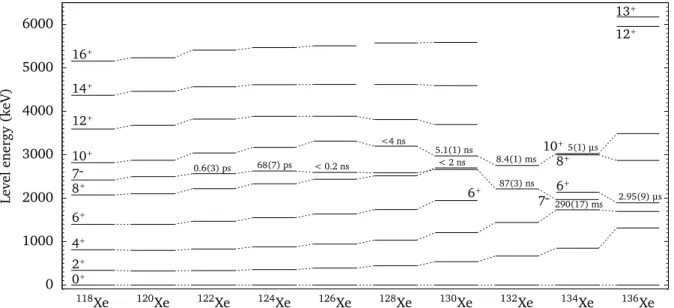
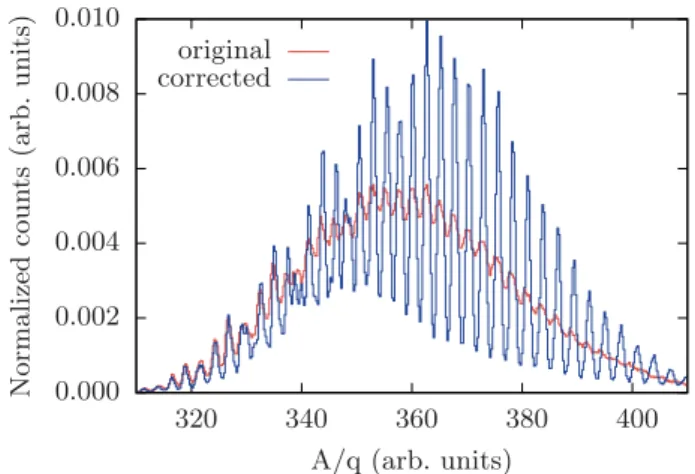
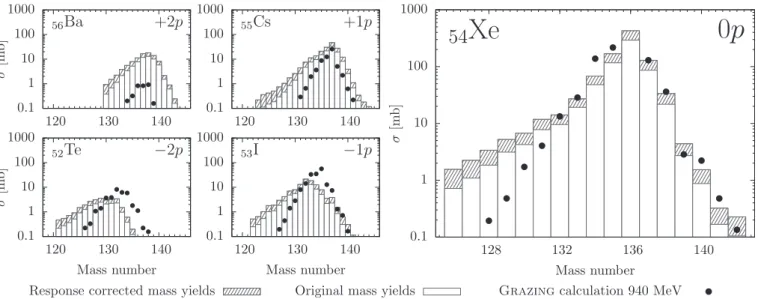
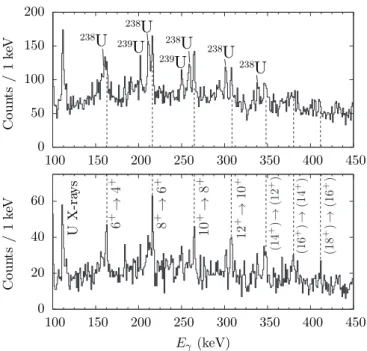
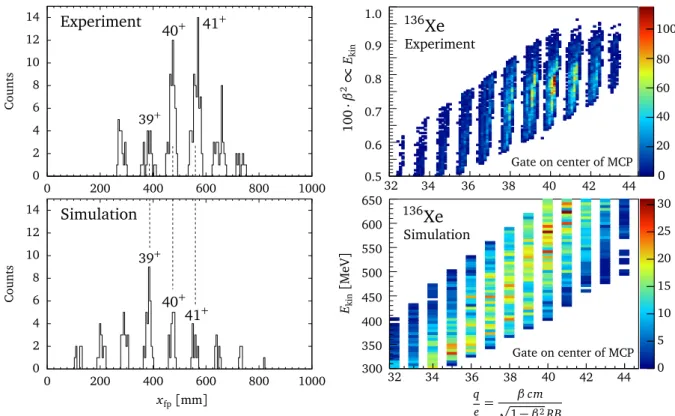
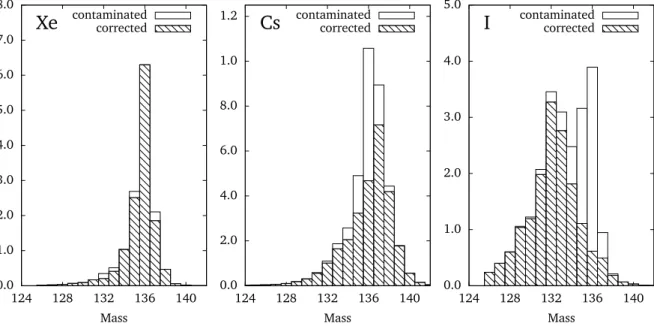
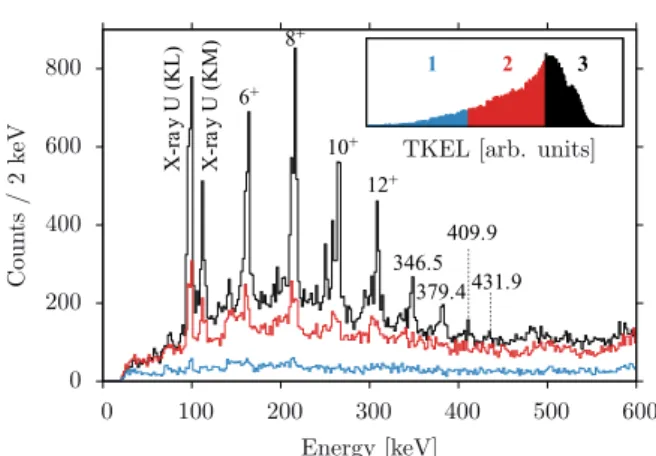
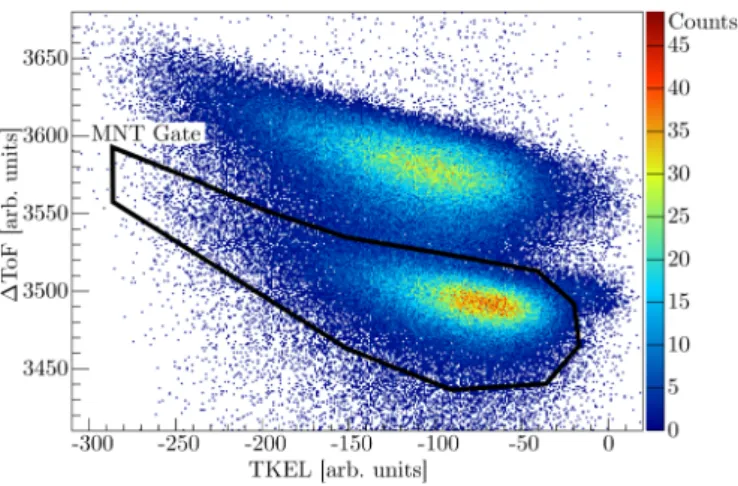
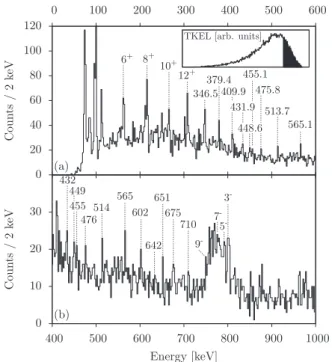
![FIG. 9. (Color online) Kinetic MoI, J kin , from this work (red [gray] points) in comparison to various theoretical predictions.](https://thumb-eu.123doks.com/thumbv2/1library_info/3701632.1506046/55.892.82.412.134.515/color-online-kinetic-points-comparison-various-theoretical-predictions.webp)